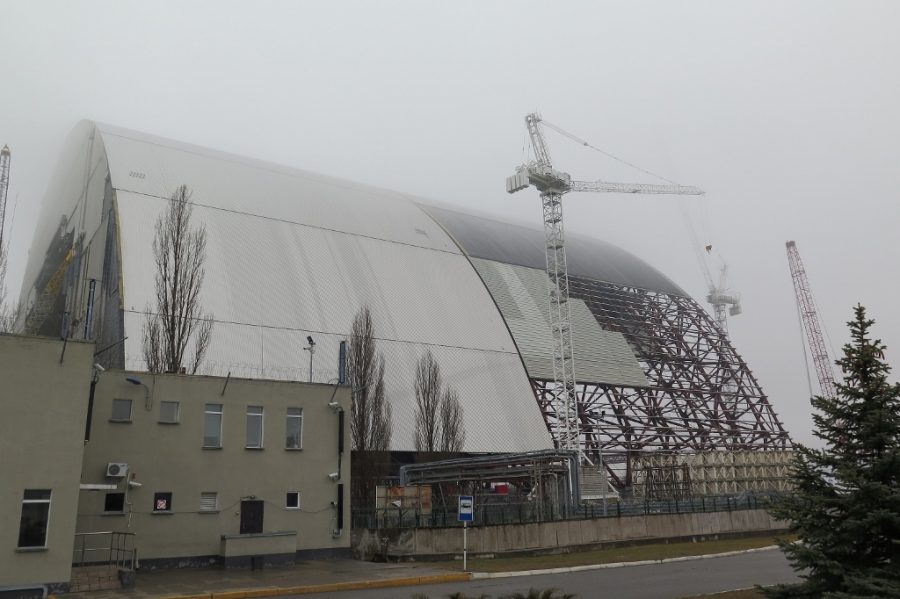Ruined Chernobyl nuclear plant to remain a threat for 3,000 years
A new sarcophagus is under construction to cover the destroyed Chernobyl Reactor No. 4. The new cover is expected to be completed in the next few years, though Ukrainians are skeptical of the schedule. (Claudia Himmelreich/McClatchy DC/TNS)
April 28, 2016
By Matthew Schofield
PRIPYAT, Ukraine — Before the fire, the vomiting, the deaths and the vanishing home, it was the promise of bumper cars that captured the imagination of the boys.
It will be 30 years ago Tuesday that Pripyat and the nearby Chernobyl power plant became synonymous with nuclear disaster, that the word Chernobyl came to mean more than just a little village in rural Ukraine and that this place became more than just another spot in the shadowy Soviet Union.
Even 30 years later — 25 years after the country that built it ceased to exist — the full damage of that day is still argued.
Death toll estimates run from hundreds to millions. The area near the reactor is both a teeming wildlife refuge, and an irradiated ghost-scape. Much of eastern and central Europe continues to deal with fallout aftermath. The infamous Reactor Number 4 remains a problem that is neither solved nor solvable.
But to the boys on the night before their world changed, nothing seemed more important than shiny blue and yellow cars, with actual steering wheels, almost ready for a 10-year-old to drive.
The bumper cars were to be turned on May 1, 1986, a seemingly impossible-to-live-through week away. So as May Day slowly neared, Alexandr Sirota and his friends couldn’t resist sneaking down into the new park after dark, beneath the deep shadows of the yet unblinking new Ferris wheel, and under the inky dark of what would soon be the electrified roof over the bumper cars.
“We’d sit in the cars and make car noises,” recalls Sirota, who’s now 40. “It was everything we could imagine wanting in life at that time. As young boys, our lives seemed perfect.”
These were the thoughts that consumed Sirota as he went to bed on April 25, 1986, and after he woke on April 26 and rushed off to School No. 1.
But as he slept, sometime after 1 a.m., the engineers who’d spent the previous 24 hours putting Reactor Number 4 through a stress test were getting nervous.
They had begun the tests full of confidence. “We knew, with certainty, with arrogant certainty, that we were in control of the power we were playing with,” recalls Sergiy Parashyn, who had been an engineer at the plant since 1977 and was summoned to the plant within an hour of the beginning of the disaster. “We could make the forces of nature bend to our will. There was nothing we could not do.”
He pauses. “This was the day, of course, when we learned we were wrong.”
Parashyn, who later would become the director of the complex and today remains one of Ukraine’s foremost experts on nuclear energy, says that as the dials indicated problems, the safe approach would have been to shut down the test.
“If we had, all would have been well,” he says. “That was not the course chosen.”
Even 30 years later, nuclear physicists familiar with the disaster disagree on what went wrong. The only area of agreement appears to be that somehow when the engineers attempted to slow the nuclear reaction by inserting control rods into the reactor core, the process actually sped up.
In a matter of seconds, the temperature inside the reactor increased by 3,000 degrees. The water used to cool the uranium suddenly evaporated, and in the sealed environment of the reactor the steam had no place to expand. That’s when the roof blew, and an estimated 10 tons of the reactor’s 200 tons of enriched uranium blasted into the sky.
Georgi Kopchinsky, who on April 26, 1986, was a director of the Soviet central committee on nuclear energy, still wrings his hands and smokes nervously as he talks about Chernobyl. He admits it’s a very tough topic for him, in part because, he says, scientists should have known it could happen.
Three years before Chernobyl, he says, Soviet authorities had warned that a similar problem had been detected at other plants with the same kind of controlling devices. But no modifications were made.
“This was our arrogance at the time,” Kopchinsky says. “We believed we were the masters of the atomic reactions. It was a horrible mistake.”
After the roof blew, the walls collapsed and the superheated uranium melted and consumed all that fell into it. All that remained to protect the world from a 2,000-ton radioactive mass that was forming was the reinforced concrete foundation and four relatively thin walls. Above was only the open sky.
The 10 tons of radioactive debris streaming into the air spread out in all directions over northern, eastern and central Europe. Eventually, a scientific report commissioned by the European Parliament would estimate that, to some extent, Chernobyl radiation contaminated 40 percent of Europe.
Officials at the Vienna headquarters of the International Atomic Energy Administration talk about Chernobyl as the moment nuclear officials around the world began to take safety seriously. Other accidents had not had the same effect. Not the explosion at Kyshtym nuclear complex in 1957 in what was then the Soviet Union, which released 70 tons of radioactive material into the air. Not the 1957 fire at the Windscale Nuclear Reactor in northwestern England, which forced a ban on milk sales for a month. Not the Three Mile Island disaster in Pennsylvania on March 29, 1979, where a cooling malfunction led to a partial meltdown.
Chernobyl, says Helen Rycraft, a senior nuclear safety officer at the IAEA and an expert in nuclear safety culture, was “a complete watershed. The entire industry changed.”
But not the problem at Chernobyl. There the ruins of the reactor building — concrete, steel, even office chairs — collapsed into the 200-ton superheated uranium core, creating a radioactive blob weighing 2,000 tons that remains beneath the site today.
Ideally, Ukraine would remove the material. Sergiy Parashyn grabs a pen and paper as he talks about the problems with that.
“We do not know how to do this,” he explains. “We do not have the technology to do this. It must be something new.”
He sketches the blob, then makes a quick drawing of a tractor with a scoop on one side and a large rotating blade on the other. He smiles at the crude drawing, then shrugs.
“One problem is that the material is decaying and is brittle, and when we cut it up to transport it to disposal bins, it will very likely fill the air with radioactive dust,” he explains. So the tractor has to be able to operate in a radioactive environment, it has to be able to control and eliminate any dust, and it has to operate in an area that won’t be at all safe for human beings. “Maybe something like this would work, maybe it wouldn’t. We don’t know. That’s a problem.”
It’s a problem because while the 5 percent of the radioactive material blown into the air caused problems that continue 30 years later, the other 95 percent of the material represents a whole different set of potential disasters, any one of which could unfold at any time.
The brittle material could be released into the atmosphere. Or it could get into the Pripyat River, which flows into the Dnieper River, the primary water source for much of Ukraine, including the capital, Kiev.
It is difficult to imagine how long Ukrainian authorities must remain on guard. Estimates suggest the Chernobyl area won’t be safe again until the year 4986. To put that in perspective, that’s a span of time that if placed against modern human history would stretch from when King David ruled Israel and before the founding of Rome to now.
Tetiana Verbytska, an energy policy expert at the National Ecological Center of Ukraine, thinks few people really understand how challenging the legacy of Chernobyl is. There’s a movement, she notes, aghast, even to shrink the radius of the no man’s land that surrounds the plant from 18 miles to six. She warns there’s no solution.
“We don’t have the technology to fix the problem,” she said. “We don’t have the process to develop the technology to fix the problem, and we don’t have the money to support the process to develop the technology to fix the problem. The solutions for our Chernobyl problems are very much ‘seal it for now.’ We will have smart children and smart grandchildren who in 100 years or so will figure out what to do.”
Sirota, of course, knew none of this that morning when he dashed from school to a bridge near the reactor where he could get a clear view of the commotion, before he spent most of the rest of 1986 in the hospital, before the years of treatment for radiation exposure, before he watched his mother’s hair fall out.
He’d never been sick a day in his life before. He was proud of that. His mother used to brag about that. But after Chernobyl, he could not be cured. For years, he would spend at least a month every year in the hospital. The official Ukrainian medical diagnosis for the many who complained of radiation-related illnesses after Chernobyl was “Radiophobia.” The so-called “Chernobyl victims” were more afraid of what had happened than actually sick, was the official line.
His eyes tear up when he looks at photos of his mother’s beautiful long blond hair.
“Most of her hair fell out,” he explains. “She cuts what’s left very short.”
Despite the health problems, Pripyat remained a fundamental part of Sirota’s dreams. He would next see the city six years later, in 1992. He and a friend sneaked in to take a look around at their old home. He remembers being most surprised by the fact that very little had changed.
When he was an adult, he decided to move back, just outside the ring of contamination, where his house cost only $125.
“I don’t eat the mushrooms from here,” he said. “I avoid eating the game. That’s what they tell us: We’re safe as long as we don’t.”
He lives with a Geiger counter around his neck. He carries a second one in case the first malfunctions.
The constant clicking as the Geiger counter measures the local radiation serves as a soundtrack to his life. Even at home, resting or cooking, it is ever present: click … click … click.
His work these days is showing visitors around the irradiated area. A couple of days a week he passes through the heavily guarded gates into the contaminated zone.
Between giving tours and doing odd jobs in and around the forbidden zone, he earns a living.
“I’m drawn to Chernobyl,” he explains. “It’s the source of the greatest sadness of my life, but that’s also because it was the source of my greatest joy. I feel that the accident at the plant stole a perfect childhood, a perfect life, from me. I know this isn’t rational, but I stay here hoping that someday I might get it back.”
———
©2016 McClatchy Washington Bureau
Visit the McClatchy Washington Bureau at www.mcclatchydc.com
Distributed by Tribune Content Agency, LLC.








